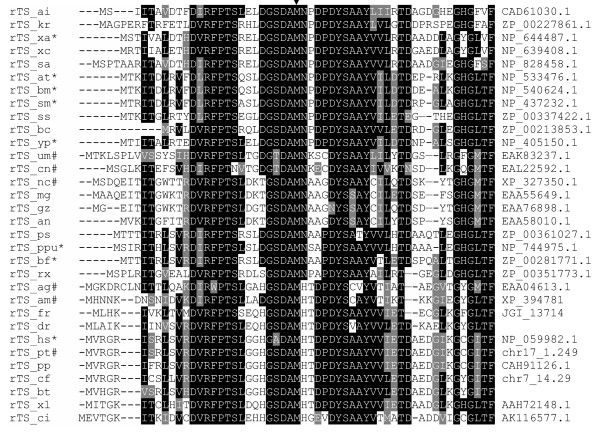Figure 2.
Sequence conservation within the extended N-terminal regions among all available rTS genes. The N-terminal section of all available rTS protein sequences were analyzed using Clustal X followed by boxshading using the BOXSHADE server [32]. The arrow indicates the start methionine in the short form of rTS proteins. Black boxed residues are identical, grey boxed residues are similar. The species name of each sequence is indicated by the last two letters in the sequence ID (ag, Anopheles gambiae; ai, Arthrobacter ilicis; am, Apis mellifera; an, Aspergillus nidulans; at, Agrobacterium tumefaciens; bc, Burkholderia cepacia; bf, Burkholderia fungorum; bm, Brucella melitensis; bt, Bos tauras; cf, Canis familiaris; ci, Ciona intestinalis; cn, Cryptococcus neoformans; dr, Danio rerio; fr, Takifugu rubripes; gz, Gibberella zeae; hs, Homo sapien; kr, Kineococcus radiotolerans; mg, Magnaporthe grisea; nc, Neurospora crassa; pp, Pongo pygmaeus; ppu, Pseudomonas putida KT2440; ps, Polaromonas sp. JS666; pt, Pan troglodytes; rx, Rubrobacter xylanophilus; sa, Streptomyces avermitilis; sm, Sinorhizobium meliloti; ss, Silicibacter sp. TM1040; tr, Takifugu radiatus; um, Ustilago maydis; xa, Xanthomonas axonopodis; xc, Xanthomonas campestris; xl, Xenopus laevis; yp, Yersinia pestis). The accession numbers of the sequences are provide in the last column of the alignment. Sequences labeled with * are those annotated with a shorter N-terminus, while those labeled with # are the ones containing extra sequences at the N-terminus (see complete sequences in Additional file 1).

